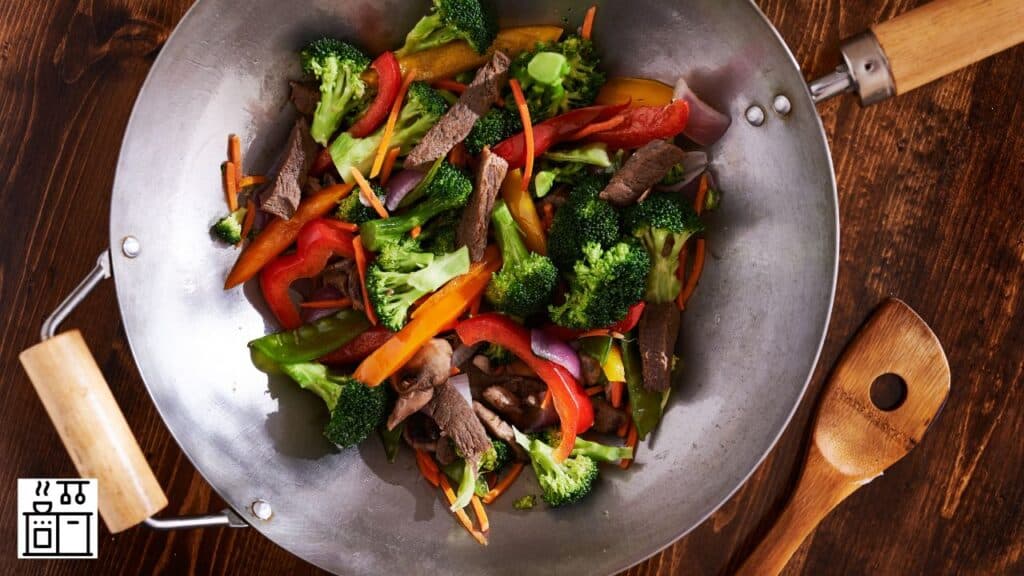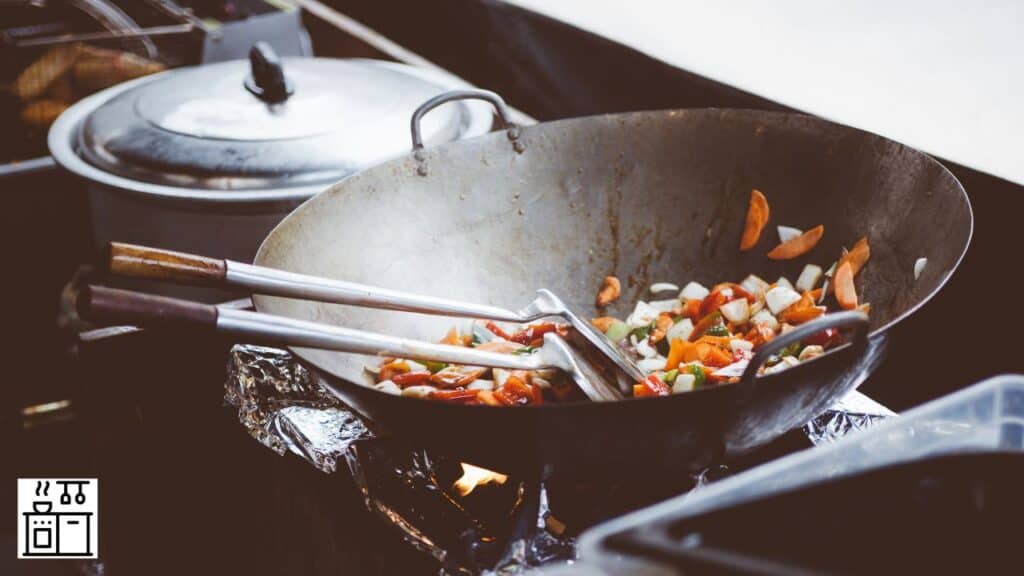The right type of cookware can make meal prep a breeze.
And when it comes to Asian cuisine and stir-fry recipes, a wok is a game-changer.
So, what is a wok?
A wok is a traditional Chinese cooking vessel with a round base and high sloping walls. Due to its distinct shape, the center becomes intensely hot while the walls remain warm during cooking. This natural heat gradient makes it easy to toss and fry ingredients quickly. It also renders a smoky flavor to the food.
Let’s take a closer look at the wok and find out how to use it.
How Does A Wok Work?
Two distinctive factors distinguish a wok from other cookware.
Firstly, it’s a deep dish with a round base. Secondly, it has a large surface area because of the high sloping walls.
This unique shape allows a wok to take a large amount of heat without using much oil.
When you place a wok on the stove, intense heat develops and concentrates in the center.
Meanwhile, the walls are also warm but not as warm as the center.
The round shape makes it easy to toss ingredients around in the wok.
The food gets cooked quickly too, making it one of the best types of cookware for stir-fry recipes.
The intense heat that a wok develops adds a signature, smoky flavor to the food, which is also a defining component of Chinese cooking.
What Can You Cook in A Wok?
The classic way to use a wok is for flash-frying.
In this technique, you heat the wok and drizzle a small amount of oil.
Then, add the stir-fry ingredients and cook them quickly at a high temperature.
This quick-frying method uses less oil but retains the original flavors and goodness of the ingredients.
In Asian cooking, woks are commonly used to prepare stir-fries.
Here, the oil is first heated, and the ingredients are then tossed with the flavoring agents until they’re fully cooked.
The main benefit of using a wok is that the cooking process takes less time.
Additionally, the food develops a delicious and distinctive smoky flavor.
It also requires less oil because of the intense heat it develops.
However, you can use a wok for much more than just stir-fry recipes.
The large surface area of this cooking vessel and its ability to build high temperatures makes it very versatile.
You can use it for boiling, frying, and steaming various ingredients.
You can even use it for cooking without fire, to perhaps toss a salad.
Apart from using woks for flash-frying and deep frying, chefs also use this utensil for pan-frying, boiling, braising, steaming, stewing, searing, poaching, and even making soups.
The size of the pan makes it convenient to cook large quantities of food.
You can use it to fry large batches of potatoes, meat, or seafood.
It’s also easy to make fried rice and other dishes that involve thorough mixing of ingredients.
You can even use it to make popcorn or taco fillings.
How to Choose the Right Wok?
Although a wok isn’t as popular as the frying pan, it’s a valuable piece of cookware that can serve multiple purposes.
Now, woks come in a wide variety of sizes and shapes.
They can also be constructed using different types of materials.
We can further differentiate woks according to the type of handles they carry.
Northern-style woks have long handles, while Cantonese-style woks have small handles on either side for easy handling.
This wide variety of choices can prove confusing when you go to buy a wok.
It’s easier to make the selection based on the following important factors that directly affect your cooking.
The most important factor when choosing a wok is the shape.
A good wok will have a well-rounded base and high walls.
Woks with bases that are too flat make it difficult to move food around and toss it in the center where the heat is concentrated.
For regular household use, woks with a maximum flat area of four or five inches in the center will work fine.
The walls should have a gentle slope that flares outward, providing plenty of high heat space.
Also, pay attention to the type of handles on a wok. Long handles make tossing and flipping easy.
However, woks with short handles are easier to lift and move.
Another important factor to consider is the material used for construction.
Let’s take a closer look at this aspect.
Different Types of Woks Based on Construction Material

Traditional Chinese woks were always made of carbon steel.
However, there are various other options in the market to choose from, each with their own specialty and properties.
Let’s look at the different options.
1. Carbon Steel Woks
Carbon steel woks are lightweight and easy to handle. They’re durable and inexpensive.
Good-quality carbon steel woks will last for decades. They heat evenly and cook food thoroughly.
The only challenge with carbon steel woks is that they are difficult to season.
While cast iron woks develop a non-sticky patina in a few uses, carbon steel woks take longer.
Until they’re well-seasoned, food can stick to the bottom, which makes cleaning difficult.
2. Cast Iron Woks
Cast iron woks are heavier than those made of carbon steel.
Hence, picking them up and tossing the ingredients around may not be too easy.
However, cast iron is a reliable and durable material.
A good cast iron wok can last a lifetime and can even be passed down generations.
They take a long time to heat, making it difficult to control the temperature of the wok.
However, they cook food evenly and thoroughly.
Cast iron also develops a beautiful layer of patina or seasoning with continuous use.
This makes the woks naturally non-stick.
Chinese cast iron woks are thin and easier to lift and toss than Western versions, which are cumbersome and heavy.
3. Stainless Steel Woks
Although stainless steel woks are easily available, they’re not the best choice for traditional recipes.
These woks don’t have nor do they develop any non-sticky quality.
They also don’t impart the characteristic “wok hei” or smoky flavor that defines Chinese and Asian cooking.
Thick stainless steel woks take a long time to heat. Additionally, they’re heavy and not easy to handle.
Food will often stick to the base, making it difficult to clean.
To overcome the stickiness, you may have to use a lot of oil.
So they’re not a practical or functional choice for cooking.
4. Non-Stick Woks
Non-stick woks have a metallic base with a non-stick coating of Teflon or PFA.
The thickness and weight of the wok will depend on the base metal, which is usually iron, steel, or aluminum.
These woks are usually lightweight and easy to handle.
However, they lack the attractive properties of cast iron and carbon steel wok.
A non-stick wok will not impart any smoky flavor to the food.
It will usually heat up too quickly and allow less control over the cooking temperature.
You should also be careful about the type of utensils and spatula you use to stir the ingredients.
Using steel or metal utensils for stirring or serving can scratch the delicate non-stick surface.
This will bring the food into contact with chemicals in the non-stick coating and pose a risk.
5. Aluminum Woks
Aluminum woks heat quickly and easily.
They distribute heat evenly over the surface, making them a good choice for preparing stir-fries and other recipes.
Aluminum is also light and easy to pick up and toss.
However, aluminum reacts with acidic ingredients in the food. It can also leach into the food.
It’s not easy to maintain aluminum because it loses its original luster and becomes dull when exposed to moisture.
Aluminum woks are also not dishwasher-friendly.

